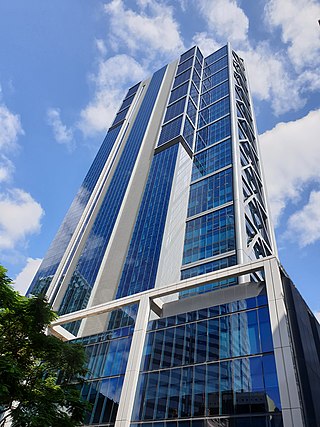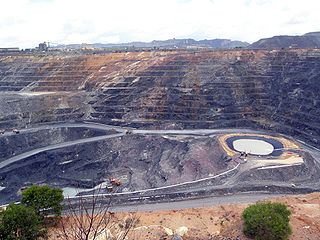
| External image | |
|---|---|
Ambrosia Lake is a uranium mining district in McKinley and Cibola counties in New Mexico north of Grants that was heavily mined for uranium starting in the 1950s. It is in an anticlinal dome. [1] [2] [3] [4] [5] [6] [7]

| External image | |
|---|---|
Ambrosia Lake is a uranium mining district in McKinley and Cibola counties in New Mexico north of Grants that was heavily mined for uranium starting in the 1950s. It is in an anticlinal dome. [1] [2] [3] [4] [5] [6] [7]
Kerr-McGee first learned about rich uranium deposits in the area in 1955. It ran a free assay service and some prospectors had sent in samples that the company found to be high in uranium. Kerr-McGee sent an agent to buy the property. This agent instead double crossed the company and bought the site for himself. Various parties (including United Western Minerals Company of General Patrick Jay Hurley) rushed into the area to get sections of property. However Kerr-McGee wound up owning most of Ambrosia Lake. [8]
Kerr-McGee then allied with Anderson Development Corporation, and Pacific Uranium Mines to form the Kermac Nuclear Fuels Corporation. They built a mill there. [1] [4] [5] When Kerr-McGee Nuclear split into Quivira Mining and Sequoyah Fuels subsidiaries in 1983, Quivira got the Ambrosia Lake property. When Quivira was sold to Rio Algom in 1989, Rio got the mine and mill. Rio was later bought by Billiton which later became BHP. [1] [2] [3] [6] [7]

By 1982, approximately 111 acres (0.4 km2) of radioactive tailings were left from almost 25 years of uranium extraction. Wind and rain spread the material over an area of 230 acres (0.9 km2). Between 1987 and 1995, the Department of Energy remediated the site, encasing 5,200,000 cu yd (4,000,000 m3) of contaminated material in a 91 acres (0.37 km2) disposal cell. [9] While the DOE/UMTRA site is closed and inactive, the former Kermac mill (under BHP ownership) continues with reclamation activities towards final closure in 2021. [10] Other cleanups at mine and mill sites in the area fall under the EPA's jurisdiction. [11]

Elliot Lake is a city in Algoma District, Ontario, Canada. It is north of Lake Huron, midway between the cities of Sudbury and Sault Ste. Marie in the Northern Ontario region. Once dubbed the "uranium capital of the world," Elliot Lake has since diversified to a hub for advanced manufacturing, forest harvesting, mine reclamation expertise, retirement living, all-season tourism and remote work.

BHP Group Limited is an Australian multinational mining and metals public company headquartered in Melbourne, Victoria, Australia.

The Kerr-McGee Corporation, founded in 1929, was an American energy company involved in oil exploration, production of crude oil, natural gas, perchlorate and uranium mining and milling in various countries. On June 23, 2006, Anadarko Petroleum acquired Kerr-McGee in an all-cash transaction totalling $16.5 billion plus $2.6 billion in debt and all operations moved from their base in Oklahoma, United States. As a result of further acquisitions, most of the former Kerr-McGee is now part of Occidental Petroleum.
Rio Algom was a mining corporation that was purchased by Billiton in 2000 and is now part of BHP.
Paladin Energy Ltd is a Western Australian based uranium production company.

Uranium mining in Utah, a state of the United States, has a history going back more than 100 years. Uranium mining started as a byproduct of vanadium mining about 1900, became a byproduct of radium mining about 1910, then back to a byproduct of vanadium when the radium price fell in the 1920s. Utah saw a uranium boom in the late 1940s and early 1950s, but uranium mining declined in the 1980s. Since 2001 there has been a revival of interest in uranium mining, as a result of higher uranium prices.
Uranium mining in New Mexico was a significant industry from the early 1950s until the early 1980s. Although New Mexico has the second largest identified uranium ore reserves of any state in the United States, no uranium ore has been mined in New Mexico since 1998.
The Australian Uranium Association was an Australian industry trade group which represented companies involved in uranium exploration, mining and export. It operated from September 2006 until 2013, after which its responsibilities were absorbed by the Minerals Council of Australia.
The Pronto Mine is an historical uranium mine located approximately 20 km south of Elliot Lake, Ontario near Spragge. The site is owned and operated by Rio Algom Ltd, has been rehabilitated and is currently undergoing environmental monitoring.
The Nordic Mine, is an abandoned uranium mine in the Elliot Lake area of Ontario, owned by Rio Algom Ltd. The site has been rehabilitated and its tailings facility is currently undergoing environmental monitoring by Denison Environmental Services.
The Lacnor Mine, is an abandoned uranium mine in the Elliot Lake area of Ontario, owned by Rio Algom Ltd. The site has been rehabilitated and its tailings facility is currently undergoing environmental monitoring by Denison Environmental Services.

Radioactive ores were first extracted in South Australia at Radium Hill in 1906 and Mount Painter in 1911. 2,000 tons of ore were treated to recover radium for medical use. Several hundred kilograms of uranium were also produced for use in ceramic glazes.

The Church Rock uranium mill spill occurred in the U.S. state of New Mexico on July 16, 1979, when United Nuclear Corporation's tailings disposal pond at its uranium mill in Church Rock breached its dam. The accident remains the largest release of radioactive material in U.S. history, having released more radioactivity than the Three Mile Island accident four months earlier.

Canada is the world's second-largest producer of uranium, behind Kazakhstan. In 2009, 20% of the world's primary uranium production came from mines in Canada. 14.5% of the world production came from one mine, McArthur River. Currently, the only producing area in Canada is northern Saskatchewan, although other areas have had active mines in the past.
Sequoyah Fuels Corporation owned and operated a uranium processing plant near Gore, Oklahoma. The company was created in 1983 as a subsidiary of Kerr-McGee. In 1988 it was sold to General Atomics.
The Cimarron Fuel Fabrication Site was a nuclear fuel production facility located by the Cimarron River near Cimarron City, Oklahoma. It was operated by Kerr-McGee Corporation (KMC) from 1965 to 1975.
The Quivira Mining Corporation was a uranium mining company owned by Kerr-McGee. It was established in 1983.

Uranium mining and the Navajo people began in 1944 in northeastern Arizona, northwestern New Mexico, and southeastern Utah.

The Olympic Dam mine is a large poly-metallic underground mine located in South Australia, 550 km (340 mi) NNW of Adelaide. It is the fourth largest copper deposit and the largest known single deposit of uranium in the world. Copper is the largest contributor to total revenue, accounting for approximately 70% of the mine's revenue, with the remaining 25% from uranium, and around 5% from silver and gold. BHP has owned and operated the mine since 2005. The mine was previously owned by Western Mining Corporation.

The United Nuclear Corporation (UNC) was a diversified nuclear mining, development, and applications company based out of the United States. Formed in 1961 as a joint venture between the Olin Mathieson Chemical Corporation, the Mallinckrodt Corporation of America, and the Nuclear Development Corporation of America, the company is most well known today as the company behind the Church Rock uranium mill spill. In 1996 the company was acquired by General Electric, and remains to oversee the decommissioning of its former sites.